THE SCREAMING MIMI
Directed by Gerd Oswald. 1958. United States.
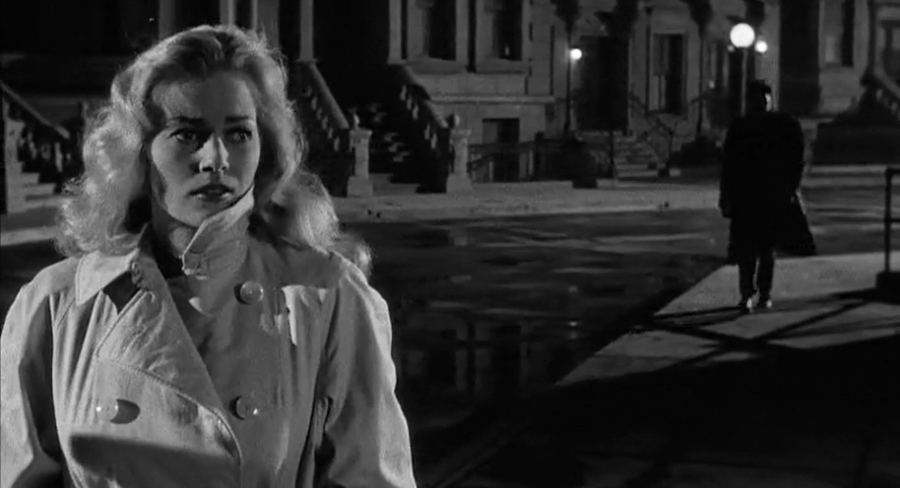
I. INTRODUCTION
Before there was such a thing as a giallo, there was the krimi. Before the krimi, there was film noir and before all of them there was the simple, unassuming pulp crime novel. It’s quite astonishing really. Considered at the time little more than sensationalist, mainstream, lowbrow literature for the lazy masses, the ripples it formed in the decades between the 1940s and 1970s were profound and far longer lasting than anyone would have ever imagined, especially in the film industry. At the start of the trend of cinematic pulp crime adaptations, there wasn’t anything like them being made in America. The early film noirs must have felt like a breath of fresh air to moviegoers in the 40s, or, if you were the optimistic, moral high ground sort, like a breath of toxic cynicism. With their often grim storylines detailing murder, blackmail, deception and seedy sexuality, the film noir redefined the American crime film from simplistic morality tales to something much more sinister and complex.
Film noir is unique in that it is (as far as I am aware) the only sub-genre defined by its presentation rather than its content. There were crime dramas and crime thrillers before film noir became a thing worth noticing, like William Wellman’s THE PUBLIC ENEMY or H.C. Potter’s BLACKMAIL, but they were more, shall we say, socially acceptable than most film noirs, often starring highly paid actors and backed by generous production budgets. The line of demarcation between the crime thrillers of the 1930s and the film noir films of the 1940s is in the look and the inspiration for the narratives. German Expressionism is all over film noirs. Heavily stylized with extreme chiaroscuro lighting schemes, film noir eschewed the typical Hollywood glamour. Instead of mining praised literary works for their inspiration, they looked to the mass appeal and cheap thrills of the pulp crime novel.
While many of the authors targeted for adaptation are well known today – like Raymond Chandler and Dashiell Hammett, for example – Fredric Brown is not. Though his Ed and Ambrose Hunter novels were popular in the late 40s, even winning Brown an Edgar Award, and his catalog of mystery thrillers is quite large, he is best known today for his science fiction writing, in particular his short story Arena, the basis for the classic Star Trek episode that aired in the first season of the show. Out of his extensive bibliography, only a handful of his novels have been adapted into films. The novel we’ll be talking about today, Dear Reader, is The Screaming Mimi.
The Screaming Mimi has been adapted twice for film, but only once by name. The first adaptation was produced in 1958, close to the end of the classical period of film noir. By the time this adaptation went before cameras, the production budgets for most of these films had shrunk to a mere pittance. Film noirs were always seen as B movies by most production houses, but finding a new noir with the look and quality of DOUBLE INDEMNITY was damn near impossible in 1958. Now I could be completely wrong with my assumptions here, but I firmly believe that many of the changes to Brown’s work that were made by director Gerd Oswald and screenwriter Robert Blees were made with ticket sales in mind rather than attention to detail, an unfortunate decision that largely neuters Brown’s original story. And this is where the obligatory SPOLIER WARNING comes into effect, because in order to know where Oswald and Blees went wrong, we have to discuss where Brown went right.
II. THE SCREAMING MIMI - THE BOOK
Brown’s novel follows a man named Sweeney, an Irish reporter for a Chicago newspaper called (amusingly enough) The Blade. Sweeney has been on one hell of a bender. For the past couple of days, maybe even weeks, he’s spent his days drunk, wandering around town in the same dirty suit. He’s been locked out of his boarding room by his landlady and fired (at least he thinks) from his job. Then one night, something extraordinary happens. He comes across a small crowd standing outside an apartment building. Curious, Sweeney takes a closer look and discovers a woman, blonde and beautiful, guarded by a large dog, lying on the floor inside the entrance to the building. As the cops arrive, the woman stirs and tries to stand. That’s when everyone sees the bloody slash across the front of her dress. “The Ripper”, someone gasps. When the woman manages to lift herself up off the ground, something else extraordinary happens. The growling beast of a dog rears up, it’s teeth grabbing a small piece of cloth attached to the woman’s dress zipper. The dog pulls at the zipper and off comes her dress, cementing Sweeney’s fascination.

A little while later, Sweeney sits on a park bench talking to God, another lousy town drunk. Inspired by God’s declaration that you can get anything you want as long as you want it bad enough, Sweeney decides to sober up. Shocked to find that he wasn’t fired from his job (his bender just so happened to coincide with his two weeks paid vacation), Sweeney takes on the unenviable task of trying to solve the ongoing case of The Ripper, a homicidal maniac that has been slashing up women for the past couple of months. Because what Sweeney wants and what Sweeney hopes to get, is Yolanda Lang, the woman he found lying in that entrance way the day before. Tracking The Ripper would mean getting in close with Yolanda. Catching The Ripper would mean her gratitude. But getting some time with Yolanda, a striptease dancer at a local night club, turns out to be more difficult than he imagined. Sweeney has to go through her manager, a man named Doc Greene. Greene and Sweeney share an immediate hate for one another.
While Sweeney waits for his chance to meet with Yolanda, he begins investigating the other murders. He sets his sights on Lola Brent, a clerk in a small bric-a-brac art store downtown and the most recent Ripper victim. Questioning the owner, he learns that Lola was fired on the day she was murdered. Lola had been skimming money from the till for weeks. During her last hours at the store, she had few customers but did sell a statuette, pocketing the money and never recording the sale. Noticing the missing item, the owner questioned her and she eventually confessed to the theft. Sweeney enquires about the statuette Lola sold that day and is shown a duplicate.
It’s about 10 inches tall, depicting the slim, nude figure of a woman, the mouth “wide open in a soundless scream”, the arms “thrust out, palms forward, to hold off some approaching horror”. The statuette, Sweeney is told, is called “The Screaming Mimi”. Sweeney buys the last available statuette and heads home, not quite knowing why he bought it in the first place. A chance conversation at a diner leads to a revelation. The Screaming Mimi has something to do with the murders. It is after all something a sadist would enjoy owning. The next day, Sweeney calls up the manager of the distribution firm that sold the statuettes to the art store downtown and learns the name of the sculptor behind the Mimi, a man named Chapman Wilson.
Sweeney spends the next couple of days learning more about the other Ripper victims, talking to everyone from cops to less-than-friendly “mugs”. With his suspicions that Greene, who Sweeney has learned is an actual, bona fide psychiatrist, is the man responsible for all these dead women, he enlists a friend to help him break into Greene’s office. Unfortunately, they find nothing incriminating. Deciding to take another angle, he learns more about Wilson, the artist who created the Mimi, and the terrible history behind the statuette. Wilson modeled it after his own sister. He hears the story of Pell, an escaped madman that murdered a slew of people before setting his sights on Bessie, Wilson’s younger sister. Before Pell could use the knife he was carrying on Bessie’s tender flesh, Wilson gunned him down, killing him. The shock led Bessie to be institutionalized. She died less than a year later.
After visiting with Wilson, Sweeney has an idea. Knowing that the murderer still possesses the only other copy of the Mimi, Sweeney talks his boss into running a front page story about the statuette. Sweeney gives the distributor a heads up on the story. He tells the man that they should begin production on a new line of Mimis, marking each one individually so sales can be tracked. The day the story breaks, Sweeney receives a phone call. There had been another attempt on Yolanda’s life. She’s gone missing, presumably walking away from her apartment in shock. But that isn’t the real big news. The Ripper is dead, fallen to his death from Yolanda’s second story apartment window, the Mimi statuette lying shattered all around him on the concrete. The Ripper even made a full confession to the other murders. And who was The Ripper, you ask? It was Doc Greene.
But something about this doesn’t seem right to Sweeney. He goes looking for Yolanda and manages to track her down with little fuss. She’s alone in a small room at a boarding house, decked out in a black wig and guarded by Devil, her loyal dog. Sweeney confronts her, revealing the terrible truth. He knows who she is. Her name isn’t Yolanda Lang. It’s Bessie Wilson. He tells her that he knows all about the attack she survived. He knows all about Pell. All about her brother. All about the Mimi. He’s figured it out. He’s figured out how Greene faked her death and took her out of the institution. And worse, he knows that she’s the killer, triggered into the horrible attacks on women by the sight of the very statuette that depicted her own close encounter with death. The night she was attacked… that wasn’t The Ripper. That was Greene. He hoped that the encounter would act as a reverse shock, sending her back into the role of victim instead of her playing out the role of her attacker. When Greene confronted her in her apartment, Devil jumped him, forcing him out of the window. His confession was done out of genuine love for her, a last ditch attempt to shield her from any consequences. Yolanda makes no attempts at answering Sweeney’s charges. Devil begins to growl, ready to pounce. As Sweeney sweats it out, waiting for the cops to arrive, Yolanda drops her dress and picks up a large knife. Sweeney’s life is saved when the cops arrive, knocking the dog unconscious and taking the murderess into custody.
As a quick page turner, The Screaming Mimi is a good read though not without its faults. Like in most detective fiction (and really, that’s what this is), clues are not really logically sussed out as much as they are intuited. And that leads to a level of disconnect I often feel with novels of this sort. I can buy the whole “putting two and two” together thing just fine, but there are numerous instances in The Screaming Mimi where Sweeney just seems to divine the answers to his questions out of the clear blue sky. We have come to expect that sort of thing from Sherlock Holmes, a man who is designed as a kind of superhero able to process multiple streams of almost imperceptible data and correlations across an impossible stream of variables, always arriving at the correct answer for no other reason than he’s Sherlock Holmes. But Sweeney is just a reporter. And moreover, the majority of his detective work involves reading other people’s reporting and interrogating suspects who would have been questioned to death back when the murders took place. His sudden realization that the Screaming Mimi has something to do with the murders is a realization founded in narrative economy more than reason and logic.
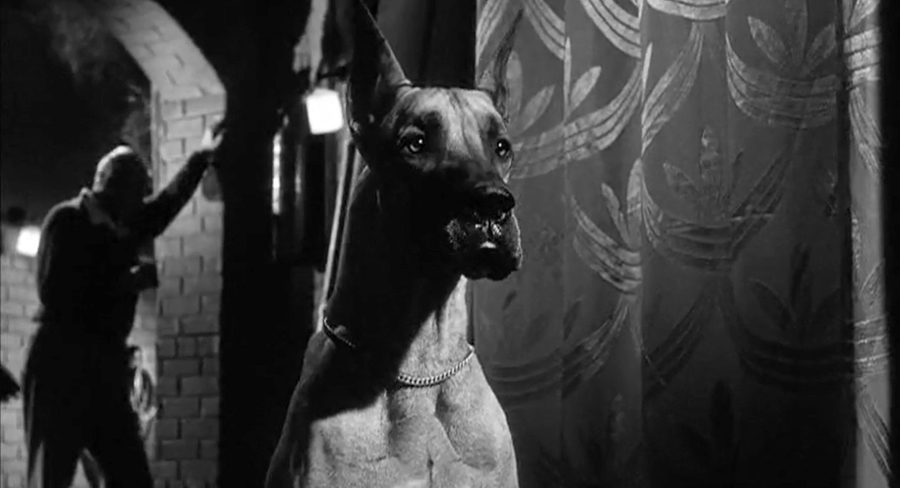
The worst thing about the Brown’s story however isn’t the leaps in logic. It’s the fact that Sweeney, as charming as he is, doesn’t do very much. Brown spends more time telling us that Sweeney wants a drink then he does incorporating Sweeney into the narrative. This is literally a narrative where the main character seems to exist outside of the story looking in instead of feeling like an integral part of the narrative momentum. At no point do we really feel like Sweeney is in danger and that makes the novel feel much more like a procedural than a thriller. While I enjoyed the novel a good bit more on my second time through, my first time reading the book I found myself just wanting something drastic to happen. As it stands, we spend a lot of time reading lines that tell us that stuff is happening but very little time actually feeling the earth move under our feet.
The novel is also dripping in homophobia, racism and sexism, but I’m willing to chalk that up to simply being a product from a much more intolerant time. Even Lovecraft, a master of horror fiction, couldn’t go a single story without his xenophobia and racism showing through.
But for all my complaints, I still enjoy the book. It’s quick, written with assured ease and great wit, and has an ending that probably would have had more of an impact had its final act reversals not been blunted by decades of imitations. There’s a fluidity and grace behind the narration, and the characters, though perfunctory, all have a unique manner of speaking that makes them feel more rounded than they actually are. It’s charming, in its own way, and it has personality. And we all know that personality goes a long way. That’s what makes the film adaptation of The Screaming Mimi such a letdown because, as we’ll soon see, the film adaptation took everything Brown worked so hard to create and turned it into a much different beast.
III. THE FILM - GERD OSWALD'S THE SCREAMING MIMI
A full plot synopsis is not necessary here as Gert Oswald’s film follows Fredric Brown’s novel fairly closely. The differences are mostly minor – Bessie’s name has been changed to the much less rural-sounding Virginia, Sweeney’s occupation has gone from straight journalist to gossip-column publicity hound, and Chapman Wilson is now Virginia’s age-improbable step brother – but there is one major difference that effectively neuters the mystery angle of Brown’s narrative and that is in the way the mystery unravels.
The film begins with Virginia, played by the buxom Swedish bombshell Anita Ekberg, running out of the ocean in a tight black swimsuit, all the better for ogling her astounding figure. She then enters an outdoor shower, strips off the swimsuit and is promptly attacked by a knife-wielding maniac. After the madman has been shot dead by Wilson, Virginia picks up the knife, screams and the film begins proper. We then transition to the Highland Sanitarium (ironically the same sanitarium our psychopath has just escaped from) where Virginia is placed under the care of Doctor Greenwood, the film’s version of Brown’s Doctor Greene. As Virginia recuperates (or rather stagnates), one of Greenwood’s colleagues notices how much time Greenwood spends with her. In an act of total unprofessionalism, Greenwood implores Virginia not to get better per se but rather to “forget it”. Just forget her trauma. Forget her experience. In other words, his “treatment” is just avoidance and it’s this little element of Oswald’s film that adds a kind of delicious irony to the proceedings.
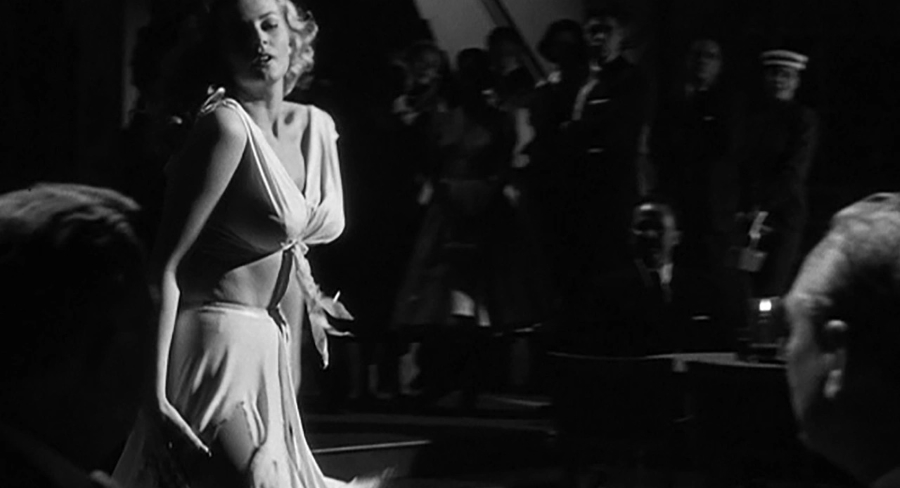
But do you notice the problem with this film’s opening scenes? The narrative of a classic detective novel is usually divided into two halves. Tzvetan Todorov divided the traditional detective novel narrative into two distinct, though interconnected, segments:
“the story of the crime, which is missing, and the story of the investigation, which is present”
This simple narrative division is what makes the solving of the crime so interesting. We begin, or we usually begin, with a dead body, the crime happening sometime in the diegetic past of the narrative. We then start, through the narrative’s detective figure, to piece together the events leading to the crime, finally arriving at an apotheosis, a conclusion or revelation that satisfies our deepest curiosities and brings the diegetic past into the present. It’s how this kind of thing works. It’s the only way this kind of thing works. But instead of slowly revealing the truth behind Virginia’s past and bringing to light the real identity of the killer, Oswald’s film presents us with the solution at the start and seeing as the film plays mostly straight with us with very little in the way of narrative complications and red herrings, anyone with a modicum of an attention span will figure the whole thing out long before Doc Greene falls to his death.
But honestly, and this is the film’s biggest, most glaring flaw, Oswald’s adaptation isn’t really interested in the mystery. Shot on the cheap (Virginia’s “door” on her “dressing room” is literally just a piece of wood with “Yolanda Lang” written in chalk on it), Oswald needed something to bring in the male viewers. So he went with Ekberg, a remarkable beauty who was, at that time, more known for her looks than her acting chops (whether or not that ever changed is something up for debate). The film’s singling her out as lead should tell you everything. In Brown’s novel, she was a silent, unattainable figure, the classic noir blonde who hides a dirty secret. Brown’s entire gag was to set Bessie (or Yolanda) up as a victim, a thing that needed protection. The last minute plot reversal serves as a pointed reminder that women are not to be underestimated, that you can in fact burn off your wings by trying to reach the sun. Brown deliberately keeps Bessie clouded in mystery. Oswald brings her front and center and really… there isn’t much of a character to deal with here.
Ekberg spends most of her on screen time talking without saying much of anything. She is obviously traumatized, often confused, and does little to inspire sympathy. She is given an opportunity to prove why she is the new hot ticket on the gentlemen’s club scene by dancing around in a barely there outfit, but it’s difficult to get your rocks off when you just spent the past twenty minutes watching her hit an emotional rock bottom. So the presentation of the character is confusing. Are we supposed to lust after this women or are we supposed to sympathize with her? Ekberg’s performance, hindered by the bewildering mess of narrative events, makes it difficult to do either.
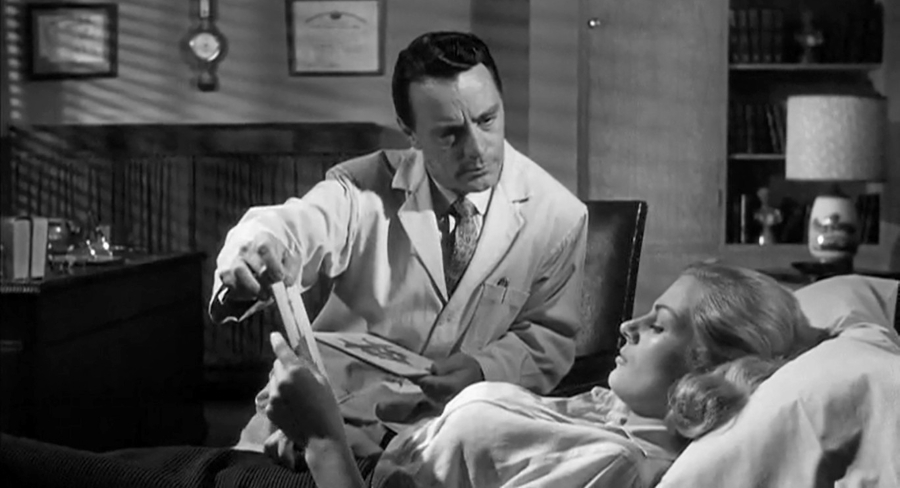
Further reducing the importance of the detective story side of things, Oswald decides to give us a weak, uninteresting love story. Sweeney and Virginia fall in love (in record time, no less) and the second half of the film splits the running time between a detective story and a love triangle melodrama. But if Sweeney is supposed to be the knight in shining armor here to rescue Virginia from the callous grasp of the evil Doctor Greenwood, Oswald’s handling of the material shoots Sweeney in the foot before he ever started to walk. Sweeney and Greenwood are more or less the same person and while Sweeney might be a bit more compassionate in his dealings with Virginia, he echoes Greenwood’s insistence that Virginia should just bury her trauma and unhappiness. Between all the melodramas and obnoxious musical performances, Sweeney does manage to find the time to crack the case, get a false confession from a dying Doctor Greenwood and confront Virginia. To say the ending feels horribly miscalculated here doesn’t do it justice. Without any kind of guiding narrative hand, the whole film feels listless and flat.
IV. THE... RIP-OFFS? ARGENTO'S SCREAMING MIMIS
Though Argento has said to have been inspired by Fredric Brown’s novel, Brown doesn’t receive a single credit anywhere on Argento’s first three films, THE BIRD WITH THE CRYSTAL PLUMAGE, THE CAT O’ NINE TAILS and FOUR FLIES ON GREY VELVET, three films which use almost the entirety of Brown’s novel when viewed together. The character of Godfrey makes an appearance in FOUR FLIES ON GREY VELVET and Sweeney’s break-in into Doctor Greene’s office finds its way into THE CAT O' NINE TAILS. But THE BIRD WITH CRYSTAL PLUMAGE uses almost all of Brown’s detective stuff, from the vital clues at the scene of an attempted murder to the artist living in obscurity with a connection to the crime, Argento wasn’t merely inspired by Brown’s novel, he lifted most of it wholesale, even if he twisted the details to fit his own imagination.
The biggest change in Argento’s adaptation (and yes, I think that word fits here) is the change of Sweeney, a newspaper reporter, into Sam, a writer. Unlike Sweeney, Sam doesn’t have an immediate, lustful attraction to the nearly murdered Monica Ranieri. He is driven solely by his own obsessive need to know what it is that went on in that art gallery. His motives are no less selfish than those of Sweeney however. Sam’s refusal to move on with his life puts his girlfriend in danger. Sweeney’s desire to solve the murder is rooted in his desire just to get in some face time with the lovely Yolanda Lang. Both characters are self-obsessed and self-destructive, both possessing vices that call into question their ability to survive their respective horror stories.
Another change, Argento turns the statue of the Screaming Mimi into a gaudy expressionistic painting, if only to make matters a bit simpler for the design team. In Oswald’s film, the statue is referred to as a “fetish”. Now a fetish does not necessarily need to be sexual, but it’s difficult to put that connotation out of mind when the film constantly parades Ekberg around like a large breasted show horse. Were the film better handled, maybe Oswald would have gone the route of Argento, providing the killer a bit more sexual relish in the act of murder. By the end of THE BIRD WITH THE CRYSTAL PLUMAGE, Argento has an insane Ranieri standing over an incapacitated Sam, all but licking her lips in anticipation of penetrating his body with her phallic blade. The Screaming Mimi in both films features a perversion of sexual conquest but only in Argento is the angle ever explored.
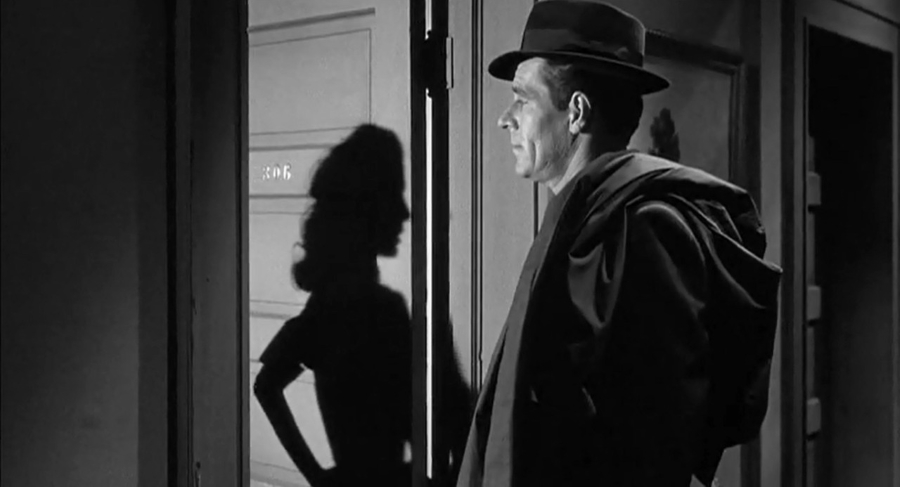
If there’s one thing Oswald’s rendition of The Screaming Mimi has over both Argento and Brown’s versions, it’s in the treatment of homosexuals. In Oswald’s film, the owner of the bric-a-brac store where the Mimi is found is a heterosexual. In Brown’s novel, he’s an almost predatory gay man. In Argento’s film, the character is no less predatory but played as the typical “funny queer” character that many Italian productions unfortunately offered up. There are gay characters in Oswald’s film however. The hostess at the gentleman’s club is clearly a lesbian sharing a room with a striking young woman and she is given royal treatment here, funny without being overbearing, written with a great deal of personality and, believe it or not, seen as perfectly normal, which of course homosexual individuals are.
But it’s really the understanding of how a murder mystery works that makes THE BIRD WITH CRYSTAL PLUMAGE soar while THE SCREAMING MIMI falls to earth with a thud. Argento keeps the traditional detective story narrative complete, doling out small clues and revelations along the way so we can compile a list of suspects in our heads. THE SCREAMING MIMI just gives us the solution and makes us wait to see how Sweeney figures it out. Strange as it may sound, I would recommend Argento’s film over Oswald’s if you were at all curious to see Brown’s novel on the screen, even if Brown’s source material has been reworked and twisted by Argento’s vision. Yes, it’s the better film of the two but it’s also the better adaptation.